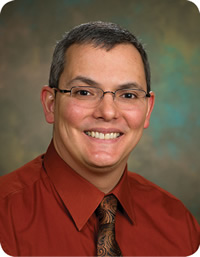Donor support makes research studies possible
Botox for kids with cerebral palsy
Can injections of Botox help children with cerebral palsy to speak better? That was the subject of a case study undertaken by Jill Meilahn, D.O., a Marshfield Clinic pediatric rehabilitation medicine specialist.
 Jill Meilahn, D.O.
Jill Meilahn, D.O.
Marshfield Clinic pediatric rehabilitation medicine specialist Botox is perhaps best known for its ability to temporarily remove facial wrinkles. But among specialists like Dr. Meilahn, this substance has been used since the 1980s with children to relieve spasticity, or the inability to relax muscles. Their overly tight muscles keep affected children from walking, speaking or even breathing properly.
Botox clearly helped address spasticity in leg muscles, allowing some children with CP to walk better. But might it also help with speech? There has been no prospective research to support such a theory.
To find out, Dr. Meilahn worked with speech pathologists to set up a series of tests to measure speech patterns before an injection with Botox, and at four weeks and 10 weeks after the injection. The tests measured how clearly they could talk, how loudly they could talk and how many words they could say in one breath. Parents were also given a questionnaire.
"The kids didn't show much physical change during any of the tests, but the parents did notice a difference," Dr. Meilahn said. "They felt the kids were up in all three categories, and the parents especially felt they could understand their children's speech better and the children would talk more to their family and friends."
Dr. Meilahn believes this study could pave the way for further, multi-center studies that could better show the benefits of Botox on speech.
Thyroid nodules
Roger Kulstad, M.D., a Marshfield Clinic endocrinologist, had a question: was it really necessary to surgically remove large nodules, or growths, found in the thyroid gland, regardless of the outcome of a fine needle biopsy?
 Roger Kulstad, M.D.
Roger Kulstad, M.D.
Marshfield Clinic endocrinologist "Previous studies suggested that thyroid biopsy results were not reliable once a nodule reached a certain size. Because of this, our current practice is to surgically remove thyroid nodules larger than 4 cm (about 1.5 inches), even if a biopsy is benign," said Dr. Kulstad.
"The big question, of course, is whether the nodule is cancerous or benign," he noted. These nodules are quite common, occurring in up to 30 percent of the general population and up to 60 percent of women over 50. Most are benign, but about 5-7 percent of them are cancerous.
"Our goal is to identify these patients using the least aggressive and invasive techniques possible. We want to catch those who need treatment, while avoiding unnecessary procedures for those at lower risk for cancer," Dr. Kulstad said.
Surgical removal requires general anesthesia and carries the usual risks inherent in any surgery. Complications are rare when expert surgeons are involved, but when they do occur, they can be devastating. Fine needle biopsy, by comparison, involves routing a very thin needle directly into the thyroid, in the patient's neck. A sample drawn through the needle is placed on a slide for analysis by a pathologist. The procedure is safe and relatively painless.
For years, doctors didn't trust those results and insisted on removing larger growths. But Dr. Kulstad wasn't so sure.
"I started noticing that the biopsy results were actually very reliable," he said. "I went back 10 years in our database, looking for all patients who had a thyroid biopsy and ultimately surgery." Those results aren't final yet, but Dr. Kulstad can say that the fine needle biopsies are much more accurate than doctors had thought.
"Let's say an 85-year-old woman comes in and has a nodule bigger than 4 cm, and her biopsy comes back benign" he noted. "Do you tell this patient you can't trust the biopsy and she needs surgery at her age?" That's an extreme example, but endocrinologists are trying to find out which patients could safely avoid surgery, perhaps using their genetic make-up.
More study is required to change the current standard. For now, Dr. Kulstad believes older patients with large nodules probably don't need to undergo surgical removal. Younger patients should be treated individually, with careful study of their situation.
